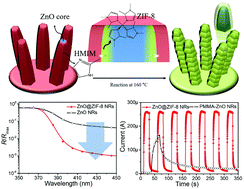Surface conversion of ZnO nanorods to ZIF-8 to suppress surface defects for a visible-blind UV photodetector†
Abstract
ZnO nanomaterials are promising building blocks for an efficient UV photodetector; however, their slow sensing behavior and undesired response to visible light, which are attributed to surface defects, such as oxygen or zinc vacancies, are challenges that remain to be addressed. Here, we transformed the ZnO nanorod surface into a zeolitic imidazolate framework-8 (ZIF-8) to eliminate ZnO surface defects. Vertical-type photodetectors were fabricated incorporating a Schottky junction at the ZIF-8/gold (Au) top electrode and could respond to UV light with a rapid response and recovery (1–2 s) and demonstrated a UV-to-visible rejection ratio in the order of 103, qualifying them as efficient visible-blind UV photodetectors. It is noteworthy that the ZIF-8 layer effectively separated the photogenerated electron–hole pairs, and thus reduced their recombination probability. The enhanced photodetector displayed excellent figures-of-merit: a responsivity of 291 A W−1 and a detectivity of 5.9 × 1013 cm Hz1/2 W−1 under illumination at 295 nm.



 Please wait while we load your content...
Please wait while we load your content...